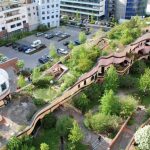
The second week of January is celebrated as “Energy Saving Week” every year in order to use energy resources rationally, without wasting, and to spread this awareness. Unnecessary energy consumption causes many environmental problems, especially climate change. In recent years, various systems have been used to reduce energy consumption in living spaces and buildings. In today’s world where energy efficiency and sustainability gain importance, “Green Building and Green Roof” applications come to the fore.
Near East University Department of Architecture Faculty Member Assist. Prof. Dr. Tuğşad Tülbentci and Head of Landscape Architecture Department Prof. Dr. Özge Özden Fuller emphasized the importance of “green building” and “green roof” applications in energy efficiency.
Assist. Prof. Dr. Tuğşad Tülbentçi: “Green buildings save energy up to 70 percent.”
Near East University Department of Architecture Faculty Member Assist. Assoc. Dr. Tuğşad Tülbentci drew attention to the fact that architects and civil engineers turn to green building designs in order to prevent unnecessary energy use in buildings. Stating that green buildings create safer and healthier living areas, Assist. Prof. Dr. Tuğşad Tülbentci emphasized that green buildings can save up to 70 percent of energy.
Stating that green buildings protect nature with their energy efficiency feature, Assist. Prof. Dr. Tülbentçi said that ecological green buildings generally use renewable energy sources such as wind and solar energy. Emphasizing that the importance of green building construction is increasing day by day in a period when natural resources are rapidly depleted and damaged. Assist Prof. Dr. Tuğşad Tülbentçi said that one of the important advantages of these buildings is that they reduce carbon dioxide production.
Assist. Prof. Dr. Tülbentçi stated that green buildings create significant gains in terms of energy saving. For example, water armatures used in green buildings consume 50 to 70 percent less water than fixtures in ordinary buildings. The savings rate it provides in electricity, natural gas or other energy sources varies between 25 percent and 50 percent. Green buildings have 25 to 50 percent lower greenhouse gas emissions than ordinary buildings. The recycling of the “gray water” obtained from rainwater, sink, shower, etc. through the treatment systems and recovering it as clean water also provides significant savings.
Prof. Dr. Özge ÖZDEN Fuller: “Green roofs are a part of the climate-resistant structure. It prevents floods and lowers the ambient temperature. “
Near East University Faculty of Architecture Head of Landscape Architecture Department Prof. Dr. Özge Özden Fuller says that the green roof application is the most commonly used architectural design to create sustainable living spaces and cities by saving energy.
Prof. Dr. Fuller said; “Green roofs have many benefits in economic, ecological and social terms. A green roof provides rainwater buffer, cleans the air, lowers ambient temperature, regulates indoor temperature, saves energy and promotes biodiversity in the city.” Saying that green roofs are used as a passive cooling technique that prevents sunlight from reaching the building structure, Prof. Dr.Fuller said “Green roofs are part of the climate-resistant construction. It prevents floods and lowers the ambient temperature.”
Green Roof Feasibility Study in Cyprus …
Speaking about the scientific study they conducted with Sinem Yıldırım, lecturer at the Department of Landscape Architecture of the Faculty of Architecture of Near East University, on green roof applications in the TRNC, which has an arid climate, Prof. Dr. Özge Özden Fuller stated that they conducted a feasibility analysis of green roof application in semi-arid climatic conditions in Cyprus by searching the literature on green roof systems and their benefits.
Expressing that the green roof feasibility study was designed for the GÜNSEL Production Facilities administration building located on the Near East University campus, Prof. Dr. Fuller said “As a result of the study, in the semi-arid climate of Cyprus, a large green roof system with roof layers and vegetation can be implemented at a low cost.” The findings obtained from the research study on scientific green roof applications were also published in the International journal of Advanced and Applied Sciences, which was scanned under ESCI in Web of Science.
Green Building and Green Roof Applications gain importance for energy saving and sustainability …
The second week of January is celebrated as “Energy Saving Week” every year in order to use energy resources rationally, without wasting, and to spread this awareness. Unnecessary energy consumption causes many environmental problems, especially climate change. In recent years, various systems have been used to reduce energy consumption in living spaces and buildings. In today’s world where energy efficiency and sustainability gain importance, “Green Building and Green Roof” applications come to the fore.
Near East University Department of Architecture Faculty Member Assist. Prof. Dr. Tuğşad Tülbentci and Head of Landscape Architecture Department Prof. Dr. Özge Özden Fuller emphasized the importance of “green building” and “green roof” applications in energy efficiency.
Assist. Prof. Dr. Tuğşad Tülbentçi: “Green buildings save energy up to 70 percent.”
Near East University Department of Architecture Faculty Member Assist. Assoc. Dr. Tuğşad Tülbentci drew attention to the fact that architects and civil engineers turn to green building designs in order to prevent unnecessary energy use in buildings. Stating that green buildings create safer and healthier living areas, Assist. Prof. Dr. Tuğşad Tülbentci emphasized that green buildings can save up to 70 percent of energy.
Stating that green buildings protect nature with their energy efficiency feature, Assist. Prof. Dr. Tülbentçi said that ecological green buildings generally use renewable energy sources such as wind and solar energy. Emphasizing that the importance of green building construction is increasing day by day in a period when natural resources are rapidly depleted and damaged. Assist Prof. Dr. Tuğşad Tülbentçi said that one of the important advantages of these buildings is that they reduce carbon dioxide production.
Assist. Prof. Dr. Tülbentçi stated that green buildings create significant gains in terms of energy saving. For example, water armatures used in green buildings consume 50 to 70 percent less water than fixtures in ordinary buildings. The savings rate it provides in electricity, natural gas or other energy sources varies between 25 percent and 50 percent. Green buildings have 25 to 50 percent lower greenhouse gas emissions than ordinary buildings. The recycling of the “gray water” obtained from rainwater, sink, shower, etc. through the treatment systems and recovering it as clean water also provides significant savings.
Prof. Dr. Özge ÖZDEN Fuller: “Green roofs are a part of the climate-resistant structure. It prevents floods and lowers the ambient temperature. “
Near East University Faculty of Architecture Head of Landscape Architecture Department Prof. Dr. Özge Özden Fuller says that the green roof application is the most commonly used architectural design to create sustainable living spaces and cities by saving energy.
Prof. Dr. Fuller said; “Green roofs have many benefits in economic, ecological and social terms. A green roof provides rainwater buffer, cleans the air, lowers ambient temperature, regulates indoor temperature, saves energy and promotes biodiversity in the city.” Saying that green roofs are used as a passive cooling technique that prevents sunlight from reaching the building structure, Prof. Dr.Fuller said “Green roofs are part of the climate-resistant construction. It prevents floods and lowers the ambient temperature.”
Green Roof Feasibility Study in Cyprus …
Speaking about the scientific study they conducted with Sinem Yıldırım, lecturer at the Department of Landscape Architecture of the Faculty of Architecture of Near East University, on green roof applications in the TRNC, which has an arid climate, Prof. Dr. Özge Özden Fuller stated that they conducted a feasibility analysis of green roof application in semi-arid climatic conditions in Cyprus by searching the literature on green roof systems and their benefits.
Expressing that the green roof feasibility study was designed for the GÜNSEL Production Facilities administration building located on the Near East University campus, Prof. Dr. Fuller said “As a result of the study, in the semi-arid climate of Cyprus, a large green roof system with roof layers and vegetation can be implemented at a low cost.” The findings obtained from the research study on scientific green roof applications were also published in the International journal of Advanced and Applied Sciences, which was scanned under ESCI in Web of Science.


